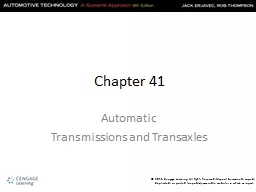PPT-Chapter 41
Author : conchita-marotz | Published Date : 2016-06-11
Automatic Transmissions and Transaxles Selects gear ratios according to engine speed power train load vehicle speed and other operating factors Most have four speeds
Presentation Embed Code
Download Presentation
Download Presentation The PPT/PDF document "Chapter 41" is the property of its rightful owner. Permission is granted to download and print the materials on this website for personal, non-commercial use only, and to display it on your personal computer provided you do not modify the materials and that you retain all copyright notices contained in the materials. By downloading content from our website, you accept the terms of this agreement.
Chapter 41: Transcript
Download Rules Of Document
"Chapter 41"The content belongs to its owner. You may download and print it for personal use, without modification, and keep all copyright notices. By downloading, you agree to these terms.
Related Documents














